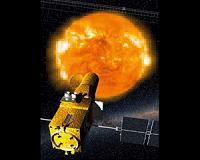 |
Paris, France (ESA) Sep 02, 2010 Cluster has spent a decade revealing previously hidden interactions between the Sun and Earth. Its studies have uncovered secrets of aurora, solar storms, and given us insight into fundamental processes that occur across the Universe. And there is more work to do. The aurora, those dancing lights in the polar skies, are but the visible manifestation of an invisible battle taking place above our heads. Supersonic particles from the Sun collide with our planet's magnetic field every day. Most are deflected away but some are trapped by Earth's magnetism and accelerated to collide with the atmosphere, creating the aurora, the planet's radiation belts and from time to time large magnetic storms worldwide. In its decade studying this activity, Cluster has discovered giant magnetic whirlpools injecting new particles into Earth's field, huge 'holes' in the uppermost atmosphere of Earth that create black regions in the visible aurora, and magnetic dead spots called nulls that form just as the magnetic landscape of space is about to snap into a new configuration. "Cluster has shown us a previously hidden world of new details," says Philippe Escoubet, ESA Cluster Mission Manager. As well as understanding the aurora, Cluster has a practical side: it unveils the environment that spacecraft such as navigation and communications satellites are expected to work in. Solar particles can damage spacecraft electronics, sometimes critically, so Cluster's characterisation of this danger can lead to more robust satellite design. There is a global science community working on Cluster. Every other day, a science team somewhere in the world has a paper accepted for publication that relies on Cluster data. The Cluster Active Archive already possesses more than 1000 users worldwide, ensuring that the science results will continue even after the mission itself comes to an end. Ten years is a long time in the severe condition of space. The four Cluster spacecraft are all showing their age and the operations team face a daily challenge to keep the fleet operational. Perhaps the biggest task is to make sure the power keep flowing. The solar panels no longer generate as much electricity as they did, and the batteries onboard are gradually breaking down in a dramatic way: a series of minor explosions. The batteries are made of non-magnetic silver-cadmium to avoid interfering with Cluster's instruments. But over time, such batteries generate oxyhydrogen, an explosive gas. To date seven batteries have cracked across the four spacecraft, two of which were more like small explosions. Ground controllers saw the spacecraft lurch each time this happened. From twenty batteries, just nine remain. Yet new, creative scenarios for operations mean the spacecraft remain almost fully functional despite the loss of battery power. And there is a lot still to be done. Recently, Cluster's approach to Earth was lowered from 19 000 km to just several hundred kilometres. This will sweep Cluster through the regions responsible for the final acceleration of auroral particles, giving scientists an unparalleled view of this behaviour. Whilst Cluster is firmly in orbit around the Earth, its science is fundamental to our understanding of the most distant realms of the Universe. "We are doing astrophysics close to home," says David Southwood, ESA Director of Science and Robotic Exploration, "Beyond the solar system is an enormous Universe, filled with uncountable stars. The spaces in between them are full of magnetic fields. Other missions study the objects - the islands in the universal ocean - but Cluster studies the very ocean itself." Cluster is expected to operate until 2012. A mission extension is under review to extend its operations to 2014.
Share This Article With Planet Earth
Related Links ESA Cluster Solar Science News at SpaceDaily
 Distant Star's Sound Waves Reveal Cycle Similar To Sun
Distant Star's Sound Waves Reveal Cycle Similar To SunWashington DC (SPX) Aug 30, 2010 In a bid to unlock long-standing mysteries of the sun, including the impacts on Earth of its 11-year cycle, an international team of scientists has successfully probed a distant star. By monitoring the star's sound waves, the team has observed a magnetic cycle analogous to the sun's solar cycle. Results of the study, conducted by scientists at the U.S. National Center for Atmospheric ... read more |
|
| The content herein, unless otherwise known to be public domain, are Copyright 1995-2010 - SpaceDaily. AFP and UPI Wire Stories are copyright Agence France-Presse and United Press International. ESA Portal Reports are copyright European Space Agency. All NASA sourced material is public domain. Additional copyrights may apply in whole or part to other bona fide parties. Advertising does not imply endorsement,agreement or approval of any opinions, statements or information provided by SpaceDaily on any Web page published or hosted by SpaceDaily. Privacy Statement |